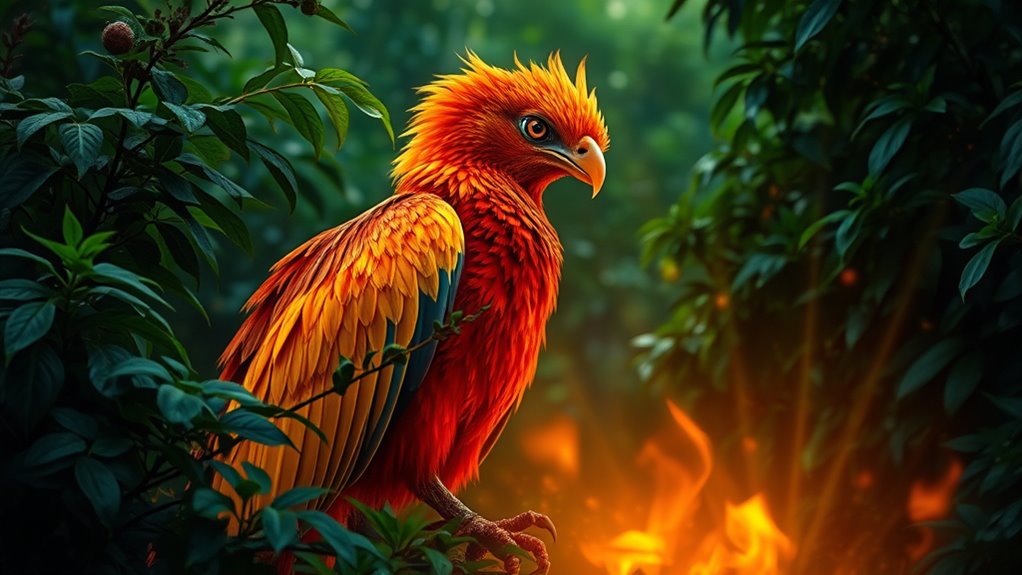The phoenix, often seen as a mythical symbol of rebirth, inspires many with its story of renewal and resilience. Although it doesn’t exist in nature, its imagery resembles birds like eagles and peacocks, which symbolize vitality and renewal in various cultures. This legendary bird represents overcoming adversity and starting anew, echoing themes of hope across civilizations. If you stay curious, you’ll discover more about the fascinating ways the phoenix continues to inspire us today.
Key Takeaways
- The phoenix is a mythical bird symbolizing renewal, resilience, and rebirth across various cultures and stories.
- Despite being mythical, phoenix imagery appears in nature-inspired art and symbolism, representing transformation.
- In some cultures, the phoenix is associated with the sun’s cycle, reflecting themes of daily death and rebirth.
- The concept of a rebirth bird influences modern symbols of hope, recovery, and overcoming adversity.
- While not real, the phoenix’s myth inspires real-world conservation efforts emphasizing renewal and resilience in nature.

Have you ever wondered if the legendary phoenix bird exists beyond stories and myths? This majestic creature has captivated imaginations for centuries, symbolizing renewal and resilience. Throughout history, the phoenix’s mythical symbolism has made it a powerful emblem of rebirth across various cultures. Its story of rising from its ashes after death resonates deeply, embodying the idea that endings can lead to new beginnings. You might find it fascinating that, despite being a myth, the phoenix’s symbolism influences real-world traditions, art, and literature, reinforcing its cultural significance in human history. Many cultures associate the phoenix with immortality, transformation, and hope, making it more than just a mythological bird—it’s a metaphor for life’s continual cycle of renewal.
In ancient Egypt, the phoenix was linked to the sun god Ra, representing the sun’s daily cycle of death and rebirth. Its presence in Egyptian mythology underscores the importance of eternal renewal, a theme that persists in many other cultures. Meanwhile, in Greek mythology, the phoenix is described as a majestic bird that bursts into flames upon death, only to be reborn from its ashes. This powerful imagery emphasizes themes of purification and resilience. Across Asian traditions, similar symbols appear—Chinese mythology, for instance, features the Fenghuang, a bird that symbolizes harmony, virtue, and renewal. These examples highlight how different societies interpret the phoenix’s mythical symbolism to express their values and beliefs about life, death, and rebirth.
The cultural significance of the phoenix extends beyond mythology and into modern symbolism. It’s often used in logos, literature, and art to evoke strength and the ability to overcome adversity. You may notice it in pop culture, representing personal growth or transformation, especially in stories of redemption and recovery. The phoenix serves as a reminder that hardship can lead to rebirth and that resilience can bring about a new chapter of life. Its enduring presence in various cultural narratives underscores its universal appeal as a symbol of hope and renewal. Whether in ancient legends or contemporary stories, the phoenix continues to inspire, reminding us that even in our darkest moments, there’s an opportunity for rebirth and new beginnings. Its mythic symbolism, rooted in deep cultural significance, makes the phoenix a timeless emblem of the human spirit’s capacity to rise anew.
Frequently Asked Questions
Are There Real Birds Resembling the Phoenix in Any Species?
You won’t find a real bird that perfectly resembles the mythical phoenix, but some species symbolize rebirth and renewal in bird symbolism. For example, the scarlet ibis with its vibrant red feathers can evoke the fiery imagery associated with the phoenix. While mythical vs. real, these birds inspire similar themes of transformation and resilience, making them powerful symbols even without the legendary flames and rebirth myth.
How Do Cultural Interpretations of the Phoenix Vary Worldwide?
You’ll find that cultural variations shape how people interpret the phoenix’s symbolism, often reflecting deeper societal values. In Western traditions, it signifies renewal and immortality, while in Chinese culture, the Fenghuang symbolizes harmony and virtue. These mythological differences highlight how interpretations adapt to cultural narratives, enriching the phoenix’s meaning worldwide. Embracing these perspectives helps you see how collective stories evolve, offering a nuanced view of rebirth and resilience across civilizations.
Can the Phoenix Symbol Be Found in Modern Literature or Media?
You’ll find the phoenix symbol frequently in modern literature and media, serving as a powerful motif of mythical symbolism and renewal. Writers and creators often reference it in novels, movies, and TV shows to depict rebirth, resilience, and transformation. Its presence in literary references underscores its enduring appeal, reminding us of the universal desire for renewal and hope amid adversity. The phoenix remains a compelling symbol across contemporary storytelling.
What Are the Scientific Explanations Behind the Phoenix Myth?
Scientists propose several hypotheses behind the phoenix myth. One suggests it’s inspired by bird species like the egret or heron, which undergo stunning molts or seasonal changes, symbolizing renewal. Another idea links ancient sightings of rare, brightly colored birds that seemed to burst into flames, sparking legends. These scientific hypotheses explore how natural bird behaviors and appearances could have fueled stories of rebirth and eternal life.
Are There Any Festivals or Rituals Dedicated to the Phoenix?
You’ll find that many cultures celebrate the phoenix through mythical celebrations and rebirth ceremonies. For example, in some traditions, people hold rituals symbolizing renewal and transformation, often involving fire or symbolic acts of rebirth. These ceremonies honor the phoenix’s legendary cycle of death and renewal, reminding you of the enduring power of rebirth. Participating in these festivals allows you to connect with cultural stories emphasizing resilience and hope.
Conclusion
As you marvel at the phoenix’s fiery revival, it’s funny how nature sometimes mirrors myth. Just like that rare bird you spot unexpectedly during your hike, the phoenix reminds you that new beginnings often appear when you least expect them. Life’s surprises, much like this legendary creature’s rebirth, show us that even amid ashes, hope sparks anew. Keep your eyes open—you never know when you might witness your own moment of rebirth close to home.









